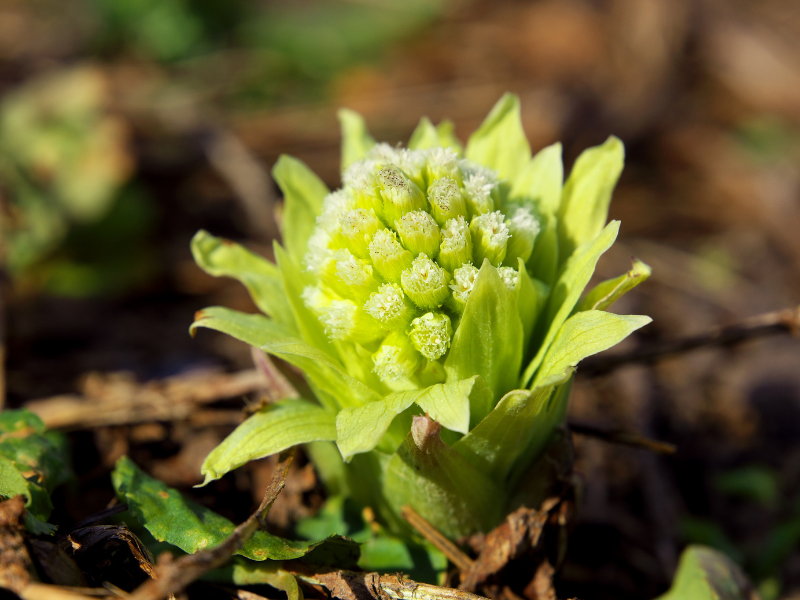
Secure Ordering | Free Shipping | 20% Off Retail Prices
Along with providing information on whether Butterbur supplements might be right for you, this article also links to Fullscript where you can buy supplements online through Fullscript’s secure healthcare formulary and get free shipping and 20% off the retail price of professional-grade supplements.
What Is Butterbur?
Butterbur is a plant with large, heart-shaped leaves and pink or purple flowers. Its scientific name is Petasites hybridus. It grows in wet, marshy areas across Europe, Asia, and North America. People have used butterbur for centuries to treat various health problems.
The roots and leaves of the butterbur plant contain natural chemicals that may help with some health issues. Some people use it to treat migraines, allergies, and asthma. However, it’s important to be careful when using butterbur. Some parts of the plant contain substances called pyrrolizidine alkaloids (PAs), which can be harmful to your liver if you consume them.
If you want to try butterbur, look for products labeled as “PA-free” to make sure they are safe. It’s also a good idea to talk to your doctor before using it, especially if you have health concerns or take other medications.
What are the Benefits of Butterbur?
Here are some potential health benefits [NBK537160]of butterbur:
- Migraine relief: Butterbur may help reduce the frequency and intensity of migraine headaches.
- Allergy relief: It may provide relief from seasonal allergies by reducing symptoms like sneezing, itching, and nasal congestion.
- Asthma support: Butterbur may help improve breathing and reduce asthma attacks in some people.
- Digestive aid: The plant has been used traditionally to treat stomach aches and other digestive issues.
Remember, it’s essential to choose “PA-free” butterbur products and talk to your doctor before using them, especially if you have health concerns or take other medications.
Is Butterbur Safe?
Overall, when taken in recommended doses and from a reputable source, butterbur appears to be safe for most people. While butterbur has been used for centuries for medicinal purposes, the safety of the supplement has been a topic of concern due to the presence of potentially harmful compounds called pyrrolizidine alkaloids (PAs). NOW® Butterbur is also free of undesirable pyrrolizidine alkaloids (PAs), so it can be used regularly. However, some butterbur supplements may still contain PAs, which can be toxic and may cause liver damage.
If you are pregnant, breastfeeding, have any underlying medical conditions, or are taking any medications. Don’t use butterbur without talking to your doctor.
Food Sources of Butterbur
Butterbur is not typically found in common foods. It is a plant that grows in wet, marshy areas and is primarily consumed in the form of supplements, teas, or extracts.
Medication Interactions with Butterbur
Some medications may interact with butterbur. These include:
- Anticoagulants (blood thinners): Butterbur may increase the risk of bleeding when taken with blood thinners like warfarin or aspirin. This interaction can be potentially severe.
- Antihypertensive medications (blood pressure drugs): Butterbur may lower blood pressure, so combining it with blood pressure medications could cause blood pressure to drop too low. This interaction may be moderate to severe.
- Sedatives (CNS depressants): Butterbur might cause drowsiness, and taking it with sedatives like benzodiazepines or sleep aids could increase this effect. This interaction may be mild to moderate.
- Antihistamines: Since butterbur may help with allergies, taking it with antihistamines could enhance their effects. This interaction may be mild to moderate, depending on the specific antihistamine.
- Liver-metabolized medications: Butterbur might affect the liver’s ability to break down certain medications, potentially increasing or decreasing their effectiveness. This interaction’s severity may vary depending on the specific medication.
Supplement Interactions with Butterbur
- Ginkgo biloba: Like butterbur, ginkgo may have blood-thinning properties. Taking both together could increase the risk of bleeding. This interaction may be mild to moderate.
- Fish oil: Fish oil also has blood-thinning effects, so combining it with butterbur might increase the risk of bleeding. This interaction may be mild to moderate.
- Vitamin E: Vitamin E can act as a blood thinner, so taking it with butterbur may increase the risk of bleeding. This interaction may be mild to moderate.
- Valerian: Valerian has sedative effects, so combining it with butterbur could enhance drowsiness. This interaction may be mild to moderate.

When you purchase linked products presented on this page, Supplement Sciences, LLC receives affiliate fees so that our dietitians can continue to create great content.
Thank you for your support!
Order Butterbur
Butterbur 75 mg with Feverfew 200 mg
Amount Per 1 Capsule Serving
Butterbur Extract … 75mg** (Petasites hybridus) (Root) (min. 15% Sesquiterpenes as Petasins)
Feverfew …. 200mg** (Tanacetum parthenium) (Aerial Parts)
This Article is Not a Substitute for Medical Advice
Dietary supplements are not designed to diagnose, treat, cure, or prevent any disease. The Supplement Sciences website seeks to provide comprehensive access to the most relevant supplement information along with convenient online ordering. We do not provide medical advice and cannot guarantee that every product suggested is completely without risk. Since each person is unique in their health history and medication use, it is important to discuss supplements with your personal physician. Specifically, pregnant women and individuals being treated for cancer or liver or kidney problems must consult their physician about every nutritional supplement they plan to take. People taking medications for the treatment of HIV or with a history of organ transplant must not take supplements without consulting with their physician.

 Scan Me!
Scan Me!

